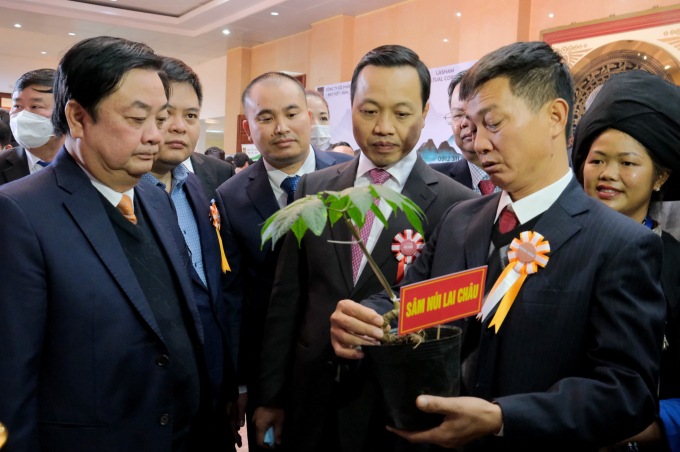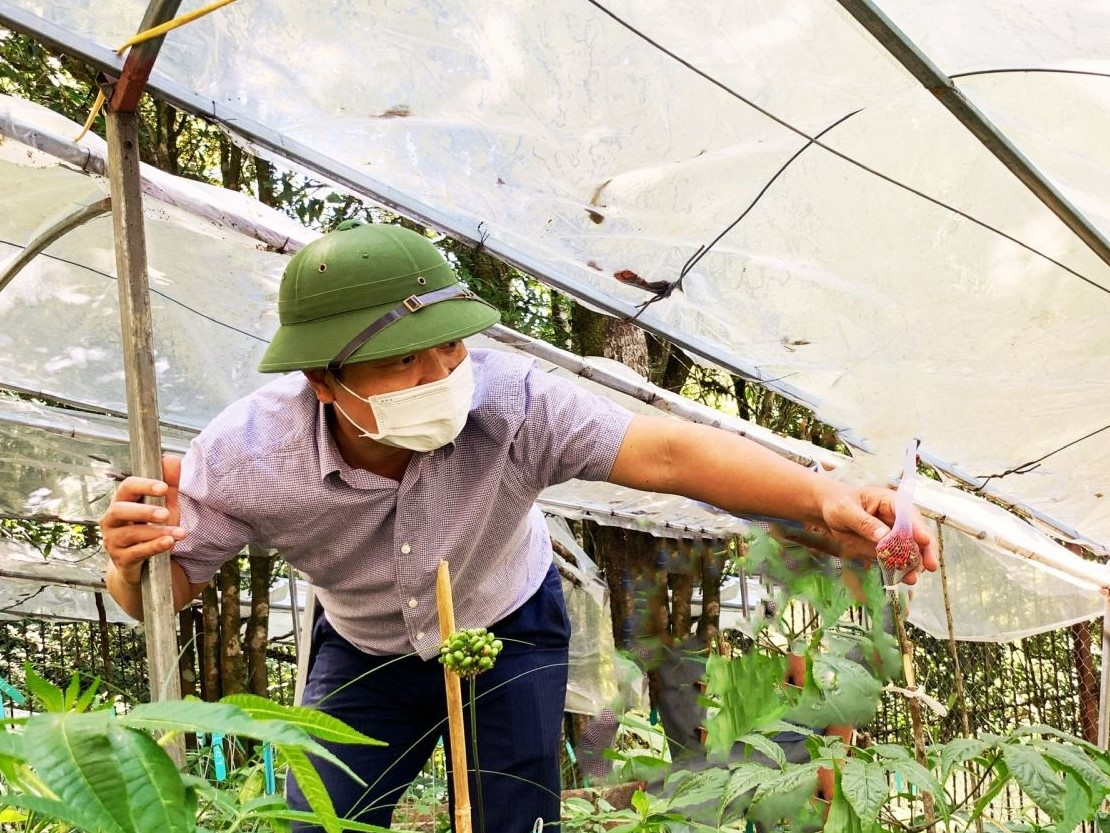June 19, 2025 | 13:38 GMT +7
June 19, 2025 | 13:38 GMT +7
Hotline: 0913.378.918
June 19, 2025 | 13:38 GMT +7
Hotline: 0913.378.918

Minister Le Minh Hoan and Chairman of Lai Chau Provincial People's Committee Tran Tien Dung at the Conference of Agricultural Investment Promotion in Lai Chau Province in 2021. Photo: Ba Thang.
At the beginning of December 2021, at the Conference of Agricultural Investment Promotion in Lai Chau province in 2021, Minister Le Minh Hoan shared that Lai Chau province needs to focus on enterprises' investment attraction to develop sustainable agriculture.
Lai Chau province has also identified the development philosophy of agriculture as oriented towards multi-value, towards concentrated commodity production, developing specialty products associated with the value chain; And to restructure and develop agriculture, the connection between people, cooperatives, and businesses to create a chain of links is very important; Contributing to helping people change their lives, reduce poverty towards escaping poverty, improve knowledge, integrate faster in the context of digital technology.
Lai Chau is a province with great potential for agricultural development. The most typical is the land fund. According to statistics, the agricultural land area is more than 526,000 hectares, accounting for 58% of the province's natural land.
The area of unused land is 240,000 hectares, and the total area of agricultural land that can be converted to some crops of higher economic value is over 60,000 hectares.
In addition, Lai Chau also has the advantage of the climate. Lai Chau has three distinct climate zones: hot and humid climates, with altitudes below 600 meters, suitable for tropical crops. The cool and moist climate zone is at an altitude of 600 meters to 1,000 meters, ideal for many subtropical plants, especially tea, macadamia, etc.
The third advantage is the diverse system of rivers and streams, suitable for growing off-season vegetables and developing medicinal plants. According to statistics, the whole province of Lai Chau has over 16,630 hectares of water surface in hydroelectric reservoirs, which is very convenient for the development of cage fish farming on the lake bed in the direction of concentration, and at the same time can be combined with the development of the tourism industry.
The most significant development obstacle of Lai Chau is traffic. Still, this bottleneck will be partially removed in the coming time to promote trade between districts in the province, between the province and the outside, and attract businesses' investment in exploiting Lai Chau's agricultural potential.
Most of the critical traffic roads in the province and the roads connecting with other provinces in the region and major markets such as the Red River Delta, Yunnan Province (China) will be completed such as Lai Chau - Sin Ho city, Lai Chau city - Nam Tam, provincial road 127, National Highway 32, National Highway 12, Hanoi - Lao Cai expressway, Ma Lu Thang - Kim Binh - Yunnan route.

Chairman of Lai Chau Provincial People's Committee surveyed Lai Chau ginseng area in Muong Te district. Photo: Tan Truong.
Regarding agricultural development strategy, Lai Chau province will focus on five main tasks as below:
Firstly, is to develop about 10,000 hectares of macadamia nut, 10,000 hectares of tea, take good care of nearly existing 13 thousand hectares of rubber, develop off-season vegetables and flowers such as passion fruit, pineapple, etc. especially developing Lai Chau ginseng.
Secondly, as livestock raising, Lai Chau province strives to have more than 36 concentrated breeding establishments, 15 establishments raising pigs towards the farming model.
The third is to develop beekeeping with 10,000 concentrated breeding colonies in the direction of control and biosecurity.
Fourth is to develop cage fish farming in hydroelectric reservoirs and cold-water fish, develop a new volume of about 45,000m3 for cage fish farming on hydroelectric reservoirs, and develop and expand the cold water fish farming area to reach 18,000m3.
Fifth is to plant about 15,000 hectares of new forests, protect about 1,000 hectares of protective and special-use forests, and about 14,000 hectares of production and scattered trees (5,000 hectares of cinnamon trees, 8,500 hectares of large timber trees).
Lai Chau's development orientation is that these tasks must be associated with deep processing, branding, organic production according to standards, and export.
The current biggest bottleneck in Lai Chau province's agricultural development is the accumulation and concentration of land to build a large production area, attracting investors to link production with farmers in the direction of production associated with processing and consuming products.
The critical factor for agricultural development is to attract investment and businesses. Significant, reputable enterprises in agriculture may not know all about Lai Chau agriculture's potential and advantages.
To attract investment in agriculture, in recent years, the People's Council of Lai Chau province has issued a Resolution stipulating policies to support linkages in production and consumption of agricultural products; Resolution regulating policies on concentrated commodity agriculture development in the 2021-202 period; Resolution on policies on sustainable forest development for the 2021-202 period.
Lai Chau province has spent a significant budget to restructure agriculture. These are policies to support the contents of seeds, materials, equipment, production and processing facilities, silvicultural road infrastructure... for businesses, organizations, and individuals investing in agricultural production.
Along with promulgating supporting policies, Lai Chau province always creates favorable conditions for businesses to explore investment opportunities.
Also, at the Conference of Agricultural investment promotion in Lai Chau province in 2021, the Ministry of Agriculture and Rural Development pledged to accompany the province to approach and support enterprises to invest in agricultural production towards sustainable, multi-valued agriculture.
Translated by Ha Phuc
![Turning wind and rain into action: [9] Digitizing hydrometeorological data in response to climate change](https://t.ex-cdn.com/nongnghiepmoitruong.vn/608w/files/news/2025/06/17/z6704423696987_15fd32ffc26d590d204d520c9dac6786-nongnghiep-165943.jpg)
(VAN) Farmers have begun accessing hydrometeorological applications to adjust their cropping schedules, aiming to ensure productivity and adapt to climate change.
![Turning wind and rain into action: [8] Real-time salinity detection and early warning technology](https://t.ex-cdn.com/nongnghiepmoitruong.vn/608w/files/news/2025/06/17/z6704423696987_15fd32ffc26d590d204d520c9dac6786-nongnghiep-151127.jpg)
(VAN) Thanks to the integration of modern hydrological-hydraulic models, remote sensing technologies, and artificial intelligence, the accuracy of hydrological forecasting has significantly improved.
![Turning wind and rain into action: [7] Early disaster warnings help marine farmers minimize losses](https://t.ex-cdn.com/nongnghiepmoitruong.vn/608w/files/news/2025/06/17/z6704423696987_15fd32ffc26d590d204d520c9dac6786-nongnghiep-142942.jpg)
(VAN) In recent years, thanks to early disaster warnings and forecasting, marine farmers in Khanh Hoa province have been able to reduce risks and losses, thereby improving production efficiency.
![Turning wind and rain into action: [6] ‘Four on-the-spot’ disaster management software](https://t.ex-cdn.com/nongnghiepmoitruong.vn/608w/files/news/2025/06/17/e5a48259d6a262fc3bb3-nongnghiep-183800.jpg)
(VAN) By simply activating the scenario on the disaster management software, the relevant authorities immediately know how many households need to be evacuated, where to evacuate them to, and by what means of transportation…
![Turning wind and rain into action: [5] Hue applies modern technology in disaster forecasting](https://t.ex-cdn.com/nongnghiepmoitruong.vn/608w/files/news/2025/06/17/z6704423696987_15fd32ffc26d590d204d520c9dac6786-nongnghiep-093938.jpg)
(VAN) In Hue city, modern technology has recently been applied in meteorological and hydrological forecasting and warning, helping to reduce the damage caused by natural disasters.

(VAN) A cutting-edge farming technique being implemented on an experimental ranch in Arizona's Sonoran Desert has already saved a billion gallons of water over five years, according to Civil Eats.

(VAN) Poultry and pig production and the environment can be boosted through enhanced water technology, according to new research.